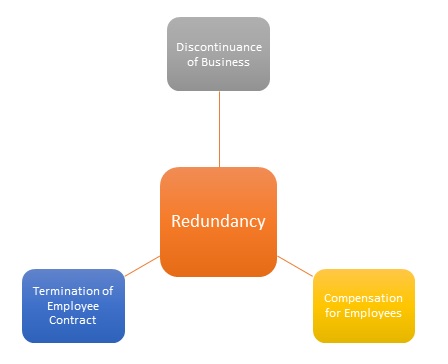- Business Concepts ›
- Human Resources (HR) ›
- Redundancy
Redundancy
Definition, Importance & Example
This article covers meaning & overview of Redundancy from HRM perspective.
What is meant by Redundancy?
Redundancy is when an employee is asked o leave or laid off if there is no work. Redundancy is one of the reasons for the dismissal of a person's employment under fixed-term contract. When a work does not exist anymore or has got diminished, the employee may be removed of his employment which is under a fixed-contract, called as Redundancy. The non-existence may be attributed to lack of projects or funds for research have stopped flowing into the system etc.
Broadly, there are two types of redundancy – Voluntary and Compulsory.
Reason for Redundancy
A redundancy usually happens because of discontinuance of business on or off the employee's site or a reduction of work or relocation of the business to a new location or change in the business processes leading to the removal of employment. This usually impacts the morale, productivity and motivation of other employees as well.

Importance of Redundancy
The concept of redundancy procedures holds good amount of importance in the establishments. Firstly, it highlights the importance of having contracts in a firm. The contracts actually decide the amount to be paid to the employee being asked to leave according to the extent of the breach of contract by the employer side. Also if the employee has ever breached a contract that can also prove to be beneficial to the employer while deciding about what to be done with the employee. Secondly, redundancy procedures should actually hold a selection criteria, for example last in first out.
This is one of the most important concepts that this procedures highlights regarding the ethics maintained in an organization. Also when an employer declares an employee as redundant, a proper legal notice must be given to the employee much before in time where the employee can search a new job for him/herself so as to replenish his/her source of earning. Also the procedure with proper notice and payments are there for employees who are considered to be in continuous employment with the organization, and the continuous employment is not hindered by sick leaves, maternity leaves or leaves due to disablements or severe accidents and injuries.
The redundant employees can claim for a compensation for the dismissal of their employment under strict time limits. The notice of redundancy to the employees has to be made at least one week prior to the removal in case the employee has worked for a period of 1month-2years, at least two weeks prior to removal in case the employee has completed 2years and one additional week for each additional year of service for a maximum of 12 weeks in total.
Example of Redundancy
Let us taken an example of a person who has been working for more than 104 weeks (minimum criteria for being considered under the benefits of redundancy dismissal of employee). But now the employer decides to declare him as redundant but says he does not owe him the benefits. The reasons the employer states is the 104 weeks employment also consists of leaves he took while on strike and also he met with an accident because of which he was an a long leave of 4 weeks. But according to the laws of redundancy procedures these leaves do not hinder the continuous employment period and the employee can file a case under the industrial dispute act.
Hence, this concludes the definition of Redundancy along with its overview.
This article has been researched & authored by the Business Concepts Team which comprises of MBA students, management professionals, and industry experts. It has been reviewed & published by the MBA Skool Team. The content on MBA Skool has been created for educational & academic purpose only.
Browse the definition and meaning of more similar terms. The Management Dictionary covers over 1800 business concepts from 5 categories.
Continue Reading:
What is MBA Skool?About Us
MBA Skool is a Knowledge Resource for Management Students, Aspirants & Professionals.
Business Courses
Quizzes & Skills
Quizzes test your expertise in business and Skill tests evaluate your management traits
Related Content
All Business Sections
Write for Us